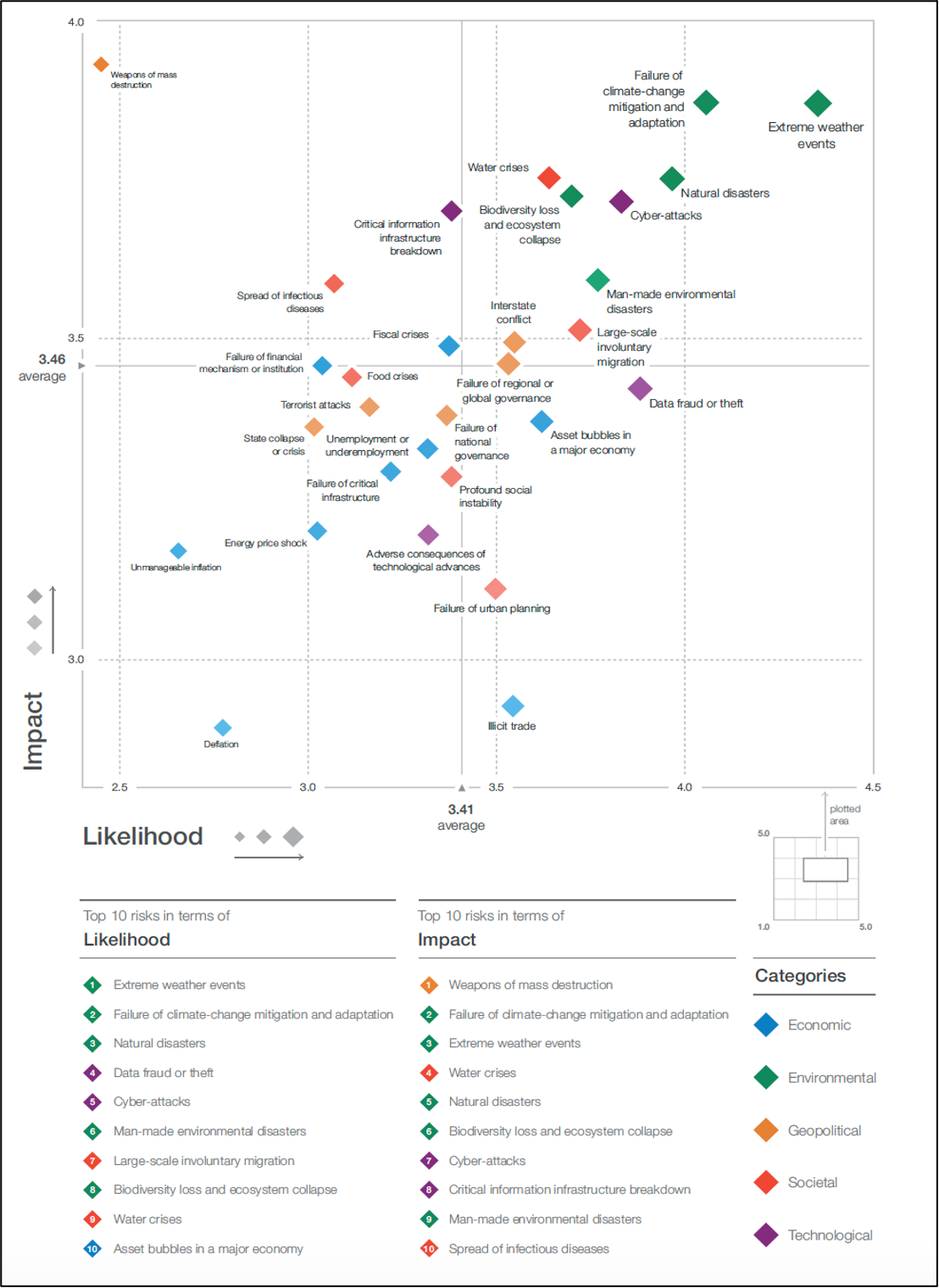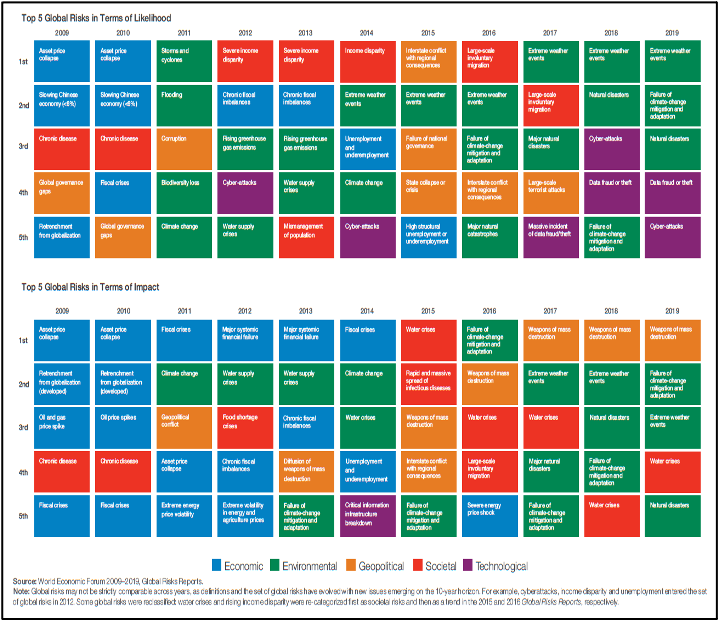The 2019 Global Risk Report by the WEF
Ref: World Economic Forum (2019). The Global Risk Report, 14th Edition.
___________________________________________________________________________
Summary
At present, spending on recovery to risk is almost 9x higher than on prevention of risk.
“Empathy underwrites all political systems that aspire to the liberal condition . . . and no amount of law or regulation will overcome a lack of empathy.”
___________________________________________________________________________
Environmental Risks
Biodiversity Loss
Species abundance is down by 60% since 1970.
The Living Planet Index, which tracks more than 4,000 species across the globe, reports a 60% decline in average abundance since 1970.
Oceans
Two-thirds of the global population is expected to live in cities by 2050. Today, ~800M people live in ~570 coastal cities vulnerable to a sea-level rise of .5m by 2050. In a vicious circle, urbanization not only concentrates people and property in areas of potential damage and disruption, it also exacerbates those risks- by destroying natural sources of resilience such as coastal mangroves and increasing the strain on groundwater reserves. Intensifying impacts will render an increasing amount of land uninhabitable. There are three main strategies for adapting to rising sea-levels:
Engineering projects to keep water out.
Nature based defenses.
People based strategies, such as moving households and businesses to safer ground or investing in social capital to make flood-risk communities more resilient.
Mean sea-level rise between 1901-2010 was 1.7mm/y. Between 1993-2010 it was 3.2 mm/y (IPCC).
In Bangladesh, a rise of .5m would result in a loss of about 11% of the country’s land, displacing ~15M people.
A study by the UK National Oceanographic Centre projects the global cost of rising sea levels at US$14T per year in 2100. It found that China would face the biggest costs in absolute terms, while as a percentage of GDP the impacts will be highest for Kuwait (24%), Bahrain (11%), the UAE (9%) and Vietnam (7%).
Food Insecurity
Micronutrient malnutrition: Impacts ~2B people; typically caused by a lack of access to food of sufficient variety and quality.
Nearly half the world’s plant-based calories are provided by just three crops: rice, wheat and maize.
A worst-case scenario—one in which the Gulf Coast ports in the US were shut down due to a hurricane at the same time as key roads in Brazil were swamped owing to heavy rains—would cut off up to half of global soybean supply in one fell swoop.”
Freshwater Access
Pollution of aquifers will be exacerbated by declines in streamflow: by the 2050s, more than 650M people in 500 cities are projected to face declines in freshwater availability of at least 10%. As rivers and streams contain some groundwater, salination could also affect surface level fresh water.
___________________________________________________________________________
Digital/Technological Risks
At least one prominent endocrinologist has likened digital technologies to addictive substances—in that they stimulate dopamine, which produces pleasure, but also require increasing use to get the same effect. Many business models rely on the efficiency with which new technologies can attract and retain users’ attention; some companies have even marketed their ability to leverage the behavioral impact of dopamine.
Researchers looking at early child development are worried less by addiction than risks of “functional impairment”—that digital technologies could crowd out interpersonal interactions that provide the building blocks for subsequent development, such as the ability to “concentrate, prioritize, and learn to control passing impulses”. The American Academy of Pediatrics now recommends that children up to 18 months old use screens only for video chats, and a limit for children up to 5 years old of one hour of “high quality” programming, watched with a parent.
___________________________________________________________________________
Societal Risks
WHO data suggesting that depression and anxiety disorders increased by 54% and 42%, respectively, between 1990 and 2013. They rank second and seventh, respectively, in the global burden of disease; five of the top 20 are mental illnesses. Worldwide, 700M people are estimated to have a mental disorder.
A US study looked at how many close friends people have: the average fell from 2.9 in 1985 to 2.1 in 2004, and the proportion of people responding that they had no close friends tripled over that period to become the modal response.
___________________________________________________________________________
Infectious Disease
Rapid and Massive Spread of Infectious Disease; Major trends have been driving an increase in the frequency of outbreaks, including:
Surging levels of travel, trade and connectivity mean an outbreak can move from a remote village to cities around the world in less than 36 hours.
High-density living, often in unhygienic conditions, makes it easier for infectious disease to spread in cities—and 55% of the world’s population today lives in urban areas, a proportion expected to reach 68% by 2050.
Increasing deforestation is problematic: tree-cover loss has been rising steadily over the past two decades, and is linked to 31% of outbreaks such as Ebola, Zika and Nipah virus.
Given that many outbreaks occur in comparatively poor countries, even economic costs that may appear low in absolute terms can have a severe impact on the countries concerned. The World Bank has estimated that the three countries most badly impacted by Ebola in 2014–15— Guinea, Liberia and Sierra Leone— suffered combined GDP losses of $2.2B. However, including the cost of associated social burdens— direct impacts on health as well as indirect effects on food security and employment—that figure jumps to US$53B. The relatively low recent death toll of infectious outbreaks—for comparison, in 1918 Spanish Influenza killed more than 50M people—can be seen as evidence climate change to alter and accelerate the transmission patterns of infectious diseases such as Zika, malaria and dengue fever.
Human displacement is a critical factor in this regard. Whether due to poverty, conflict, persecution or emergencies, the movement of large groups to new locations— often under poor conditions— increases displaced populations’ vulnerability to biological threats. Among refugees, measles, malaria, diarrheal diseases and acute respiratory infections together account for between 60 and 80% of deaths for which a cause is reported.
The H5N1 strain of influenza, for example, has a staggering case fatality rate (CFR) of above 50%; by comparison, the fatality rate for Spanish Influenza in 1918 was under 2.5%, and for seasonal influenza it is less than 0.1%.
___________________________________________________________________________
Future Risks
Weather Manipulation
Widening Gulf between Urban and Rural Areas
Digital Panopticon
Freshwater Loss
___________________________________________________________________________
Terminology
Fourth Industrial Revolution: The blurring of the line between human and technology.
___________________________________________________________________________
Chronology
2018: UK Researchers find that people spend an average of 24h/wk online, more than 2x as much as in 2011.-2019 GRR by WEF.
2018: The IPCC states that the world has at most 12 years to make the drastic and unprecedented changes needed to prevent average global temperatures from rising beyond the Paris Agreement’s 1.5ºC target.-2019 GRR by WEF.
___________________________________________________________________________

